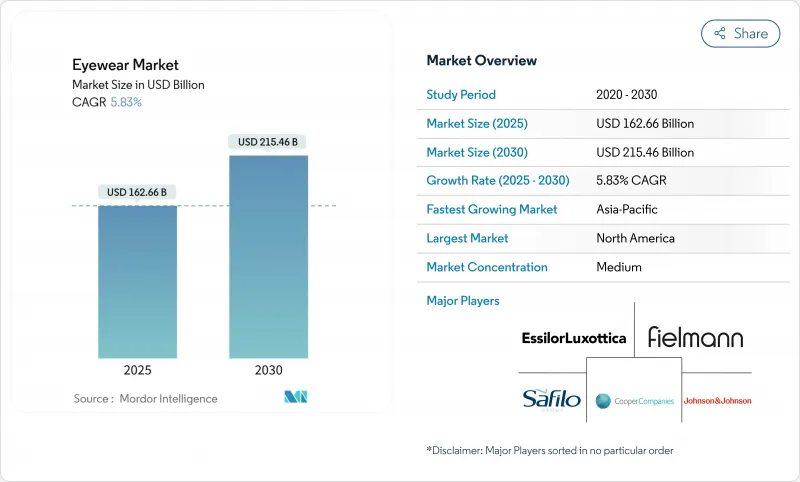
|
市場調査レポート
商品コード
1850332
アイウェア:市場シェア分析、産業動向、統計、成長予測(2025年~2030年)Eyewear - Market Share Analysis, Industry Trends & Statistics, Growth Forecasts (2025 - 2030) |
||||||
カスタマイズ可能
適宜更新あり
|
|||||||
| アイウェア:市場シェア分析、産業動向、統計、成長予測(2025年~2030年) |
|
出版日: 2025年06月25日
発行: Mordor Intelligence
ページ情報: 英文 152 Pages
納期: 2~3営業日
|
概要
アイウェアの世界市場は、2025年に1,622億6,000万米ドルと評価され、2030年には2,154億6,000万米ドルに達し、CAGRは5.83%を記録すると予測されています。

市場の成長は、健康意識の高まり、スマートグラスの採用、医療上の必要性とファッションとしてのアイウェアの二重認識から生じています。技術の進歩は業界を再形成しています。拡張現実(AR)フレームはデジタル環境と物理的環境を組み合わせ、従来の視力矯正の枠を超えた広がりを見せています。人工知能(AI)はフィッティングプロセスを強化し、アイウェアの正確な選択を可能にします。こうした技術統合は、従来のレンズやフレームの販売にとどまらず、新たな収益源を生み出します。一方で、偽造品リスクや原材料費の高騰が利益率の維持に課題を投げかけており、企業は認証ツール、多様なサプライチェーン、価格決定力を守るためのプレミアム・ポジショニングへの投資を促しています。
世界のアイウェア市場の動向と洞察
高級サングラスとプレミアムサングラスへの需要の高まり
高級サングラス市場は、消費者がサングラスを機能的な目的を超えたステータスシンボルとして捉えていることから成長を続けています。特にZ世代の消費者は、高級サングラスをプレミアム・ファッションへの身近な入口と考えています。可処分所得の増加、ファッション嗜好の変化、目の保護に対する意識の高まりが、高級サングラスに対する消費者の需要を後押ししています。消費者は革新的なデザイン、定評のあるブランド名、高品質の素材を組み合わせたプレミアム価格のサングラスを購入する意欲を高めています。高度なレンズ技術、持続可能な素材、カスタマイズオプションの統合は、高級サングラスの魅力をさらに高めています。有名ファッションブランドとアイウェアメーカーとのコラボレーションは、独占性を生み出し、ブランド価値を強化することで市場成長を促進します。例えば、2025年2月、Maison MargielaとGentle Monsterは、2023年と2024年に成功したコレクションに続き、3回目のコラボレーションを発表しました。このコレクションは8種類のサングラスデザインと12種類の眼鏡フレームが特徴で、前回のリリースでは売り切れが続出しました。
視力問題の増加
近視、遠視、乱視などの屈折異常の世界的な増加により、視力矯正とUVカットを兼ね備えた度付きサングラスの需要が高まっています。世界保健機関(WHO)の報告によると、世界中で少なくとも22億人が近視または遠視の問題を抱えており、視力矯正ソリューションの大きな市場ポテンシャルが浮き彫りになっています。2023年のBritish Journal of Ophthalmology(BJO)によると、近視は世界の子供と青少年の3分の1を占めており、早期の視力矯正が必要であることを示しています。フォトクロミックレンズ技術の進歩は、機能性の向上を通じて度付きサングラス市場を強化します。2024年4月、Indizen Optical Technologies of America(IOTアメリカ)は、Neochromes FT-28フラットトップ・ポリカーボネート・フォトクロミックレンズを発売し、光適応能力と耐久性を強化し、遠近両用レンズ分野を強化しました。スクリーン使用時間の増加はデジタル眼精疲労の増加につながり、ブルーライトフィルターレンズの採用を促進します。さらに、新興国市場では人口の高齢化が進み、特殊な視力矯正製品に対する需要が高まっています。
偽造品の拡散
eコマース・プラットフォームを通じた偽造サングラス販売の増加は重大な課題です。この問題は、匿名のベンダーのアカウントと魅力的な低価格に起因しています。これらの要因により、消費者は意図せず模倣品を購入してしまい、正規のメーカーや小売業者に損害を与えています。偽造サングラスは、規格外の素材や不十分なUVカットにより、目に永久的な損傷を与える可能性があるため、健康と安全に深刻なリスクをもたらします。これらの製品は消費者に肉体的な危害を与えるだけでなく、正規ブランドに対する消費者の信頼も失墜させる。偽造サングラス製造における低品質素材の使用、不適切な製造工程、品質管理の欠如は、安全性に重大な懸念をもたらします。米国税関・国境警備局(CBP)の2024年度知的財産権押収統計によると、偽造サングラスの押収数は2023年度の140万個から770万個に増加しており、市場で問題が拡大していることを示しています。また、2025年6月、オヘア空港の税関職員が63万8,000米ドル相当の偽造高級品の貨物を押収しました。ファッション・サングラス」と表示された貨物を検査したところ、ルイ・ヴィトン、ヴェルサーチ、シャネルといった有名デザイナーの偽造商標で飾られた61組が見つかりました。
セグメント分析
2024年のアイウェア市場では、視力矯正のニーズの高まりによりメガネが67.35%のシェアを占めました。このセグメントの成長は、スクリーン使用時間の延長、人口動態の高齢化、世界的な近視率の上昇によって続いています。仕事や余暇活動でのデジタル機器の普及は眼精疲労の問題を激化させ、高齢者への人口構造のシフトは老眼鏡や遠近両用メガネの必要性を高めています。コンタクトレンズの売上成長は、アクティブなライフスタイルを好む消費者の嗜好、レンズ素材の技術的改良、安定した収益源を生み出す定期的な交換サイクルに起因しています。
サングラス分野は2030年までCAGR 6.24%で成長すると予測されます。UVカットに対する意識の高まりと目の健康への関心の高まりに後押しされ、サングラス分野は世界のアイウェア市場で急成長しています。ファッション動向は、有名人の支持と相まって、サングラスを際立ったスタイル・ステートメントに昇華させ、多様な年齢層の需要に拍車をかけています。さらに、偏光サングラスやスマートサングラスなどの技術的進歩がハイテクに精通した消費者を魅了し、市場の成長を後押ししています。
2024年には、大衆市場向けフレームが市場の68.55%を占め、売上を独占しました。この成功は、生産におけるスケールメリットと、幅広い所得層に支持される価格戦略によるものです。小売業者は、標準化されたデザインと強固なグローバル供給ネットワークを活用し、アイウェアが多くの人々の定番となることを確実にしました。大量生産と効率的な流通を特徴とする量販店部門は、広大な小売店舗数を誇り、財布にやさしい価格で多様な商品を提供することができます。このセグメントの強さは、都会でも田舎でも顕著で、価格への敏感さが購買の意思決定を左右することが多いです。
一方、プレミアム・セグメントは上昇基調にあり、2030年までCAGR 6.54%で拡大すると予測されています。この成長の原動力となっているのは、購買意欲の喚起とファッション動向の変化です。特に若い消費者は重要な存在であり、限定品やデザイナーとのコラボ商品をマストハブ・コレクタブルとして扱っています。経済の逆風に直面しても、こうした熱意がプレミアム・セグメントの拡大を後押ししています。高い値札をつけるために、プレミアムブランドはユニークなデザイン、最高級の素材、独占的なコラボレーションを強調し、個性と品質を優先する目の肥えた消費者にアピールしています。さらに、ソーシャルメディアやインフルエンサーによる推薦の急増は、高級アイウェアの地位を、憧れのライフスタイルの象徴として確固たるものにしています。
地域分析
北米は2024年のアイウェア市場収益の33.53%を占め、消費者の高い購買力、包括的な保険適用、スマートなアイウェアフレームを採用する消費者の準備に支えられています。この地域の市場支配力は、先進的な小売インフラ、目の健康に対する意識の高まり、視力矯正を必要とする高齢化人口の増加によってさらに強化されています。
アジア太平洋地域は2030年までCAGR 8.04%で成長し、最も急成長する市場になると予測されています。この成長の背景には、近視患者の増加、中間所得層の増加、モバイルコマースの普及があります。中国は、特に機能的なアイウェアにおいて、政府主導の農村視力検査プログラムに支えられた主要市場であることに変わりはないです。この地域の成長は、急速なデジタル化、若年層のスクリーン利用時間の増加、eコマースの普及拡大によってさらに加速しています。
欧州は、確立された職人技と強力な高級ブランドの存在感により、安定した成長を維持しています。イタリアとフランスのメーカーは引き続き世界の動向に影響を与え、プレミアム価格帯を維持しています。この地域は、持続可能な素材とバイオプラスチックのイノベーションに注力しており、低価格の輸入品に対する競争力を維持しています。欧州メーカーは、革新的なレンズ技術やフレームデザインを生み出すため、研究開発に投資しています。南米と中東・アフリカ市場は、都市化の進展、ヘルスケア施設の改善、個人消費の増加に牽引され、成長の可能性を示しています。これらの地域では、眼鏡小売チェーンが急速に開発され、国民の間で視力ケアのニーズに対する意識が高まっています。
その他の特典:
- エクセル形式の市場予測(ME)シート
- 3ヶ月間のアナリストサポート
よくあるご質問
目次
第1章 イントロダクション
- 調査の前提条件と市場の定義
- 調査範囲
第2章 調査手法
第3章 エグゼクティブサマリー
第4章 市場情勢
- 市場概要
- 市場促進要因
- 高級・プレミアムサングラスの需要増加
- 視力障害の増加
- 技術の進歩とスマートなアイウェア
- 紫外線対策と目の健康への意識の高まり
- 有名人の推薦とソーシャルメディアの影響
- Eコマースとオンライン試着サービスの拡大
- 市場抑制要因
- 偽造品の蔓延
- 視力矯正手術
- 原材料価格の変動
- 調査、設計、技術にかかる高コスト
- 消費者行動分析
- 規制の見通し
- ポーターのファイブフォース分析
- 供給企業の交渉力
- 買い手の交渉力
- 新規参入業者の脅威
- 代替品の脅威
- 競合の程度
第5章 市場規模と成長予測
- 製品タイプ別
- 眼鏡
- サングラス
- コンタクトレンズ
- その他の製品タイプ
- カテゴリー別
- マス
- プレミアム
- エンドユーザー別
- 男性
- 女性
- ユニセックス
- 流通チャネル別
- オフラインストア
- オンラインストア
- 地域別
- 北米
- 米国
- カナダ
- メキシコ
- その他北米地域
- 欧州
- ドイツ
- 英国
- イタリア
- フランス
- スペイン
- オランダ
- ポーランド
- ベルギー
- スウェーデン
- その他欧州地域
- アジア太平洋地域
- 中国
- インド
- 日本
- オーストラリア
- インドネシア
- 韓国
- タイ
- シンガポール
- その他アジア太平洋地域
- 南米
- ブラジル
- アルゼンチン
- コロンビア
- チリ
- ペルー
- その他南米
- 中東・アフリカ
- 南アフリカ
- サウジアラビア
- アラブ首長国連邦
- ナイジェリア
- エジプト
- モロッコ
- トルコ
- その他中東・アフリカ地域
- 北米
第6章 競合情勢
- 市場集中度
- 戦略的動向
- 市場シェア分析
- 企業プロファイル
- EssilorLuxottica SA
- Safilo Group SpA
- Fielmann AG
- Johnson & Johnson AG
- The Cooper Companies Inc.
- Alcon Inc.
- Bausch+Lomb Corp.
- Carl Zeiss AG
- De Rigo Vision SpA
- Charmant Group
- Hoya Corporation
- Warby Parker Inc.
- Lenskart Solutions Pvt. Ltd.
- Marchon Eyewear(VSP Global)
- Maui Jim Inc.
- Zenni Optical Inc.
- Marcolin SpA
- Inspecs Group PLC
- Hangzhou Lingban Technology Co., Ltd
- Kering S.A

